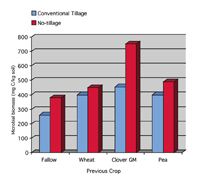
Features
Agronomy
Soil
Direct seeding improves soil biological health
Invisible to the naked eye, soil microbes play a big role in many beneficial crop production processes that include nutrient cycling and biological disease/pest control. Agriculture and Agri-Food Canada researcher Newton Lupwayi says that, given the importance of soil microbes, farmers should implement practices that encourage their beneficial activities.
December 3, 2008 By Bruce Barker
Crop and environmental benefits occur.
 |
| No-till creates an environment conducive to improved soil health. Photo courtesy of Bruce Barker. |
Invisible to the naked eye, soil microbes play a big role in many beneficial crop production processes that include nutrient cycling and biological disease/pest control. Agriculture and Agri-Food Canada researcher Newton Lupwayi says that, given the importance of soil microbes, farmers should implement practices that encourage their beneficial activities. “What you want to do is support soil microbial communities. Direct seeding is one of those ways,” says Lupwayi, who works at AAFC at Beaverlodge, Alta.
Lupwayi cites a research project where he looked at microbial populations and activity under direct seeding. He looked at the tillage effects on soil microbial biomass in various rotations in a Gray Wooded Soil at Fort Vermilion, Alta. Fallow, wheat, green manure clover and pea were grown in rotation. He conducted microbial measurements on the wheat crop, when grown on these four crop stubbles.
Looking at microbial biomass (the weight of soil microbes) in the top three inches, Lupwayi found that no-till plots had significantly higher mass of soil microbes than conventionally tilled plots. He also looked at the diversity of soil bacteria in these plots, and found that no-till plots had greater diversity than conventional tillage.
 |
|
Figure 1. Tillage effects on soil microbial biomass in various rotations at Fort Vermilion, Alberta. GM = green manure. SOURCE: Lupwayi, AAFC. |
Soil microbial activity, though, can be lower under direct seeding – and that can be a good thing. When measuring carbon dioxide emission from the plots, carbon dioxide release was lower under no-till than conventional tillage. The reason is that under no-till, the soil has better tilth and larger soil aggregates, which help to protect the organic C in the soil from microbial attack. Also, tillage mixes oxygen into the soil and results in increased C decomposition as well.
“Carbon sequestration and reduction of greenhouse gases is a major benefit of no-tillage, but even though farmers can now capture some of those benefits monetarily through trading in carbon credits, for most farmers, the largest benefits of no-tillage are the agronomic benefits of a healthier, more productive soil,” says Peter Gamache, team leader with Alberta Reduced Tillage LINKAGES (RTL) at Edmonton.
In undisturbed soil, most biological activity is found in the top 8 to 12 inches of the rooting zone. Here, the rhizosphere has intense microbial activity with 5,000 to 10,000 species of microorganisms per gram of soil.
Lupwayi found that stratification of soil microbes was evident under no-till. When sampling to a seven-inch depth, he found that no-till increased microbial biomass in the top three inches of soil, and then was similar to the biomass found with conventional tillage.
 |
|
Table 1: Effect of Tillage on Soil Organic C and Soil Organisms. Source: Lupwayi, AAFC.
|
Why greater microbial biomass?
According to Lupwayi, soil microorganisms depend on soil organic C for energy and cell synthesis. Since no-till increases, or sequesters, soil organic C, there is more C for microbes to feed on. As a result, there is a greater soil microbial biomass, and greater diversity than under conventional tillage. “Any system that increases and affects the amount of organic C in the soil, will also affect the soil microbes in the soil,” says Lupwayi. “So things like tillage, which affect soil moisture, soil temperature, and organic C can also affect microbes.
”In addition to reducing the physical disturbance of the soil, Lupwayi explains that direct seeding also leaves residues on the soil surface. The residues from successive years and diverse crops result in a greater variety of food sources than in tilled soils where surface residue does not build up. He says that tillage also mixes the residue more uniformly. As a result of these factors, the diversity of food sources under direct seeding results in a more diverse microbial community than under conventional tillage. “Since direct seeding improves the biological health of the soil, it follows that crops grown under direct seeding benefit from the various biological processes that occur in healthy soils,” summarizes Lupwayi.